Best exercise bikes 2025: Boost your fitness with these home spin bikes
These are the best exercise bikes for training at home, whether you're taking part in classes with motivational trainers or smashing intervals on your own
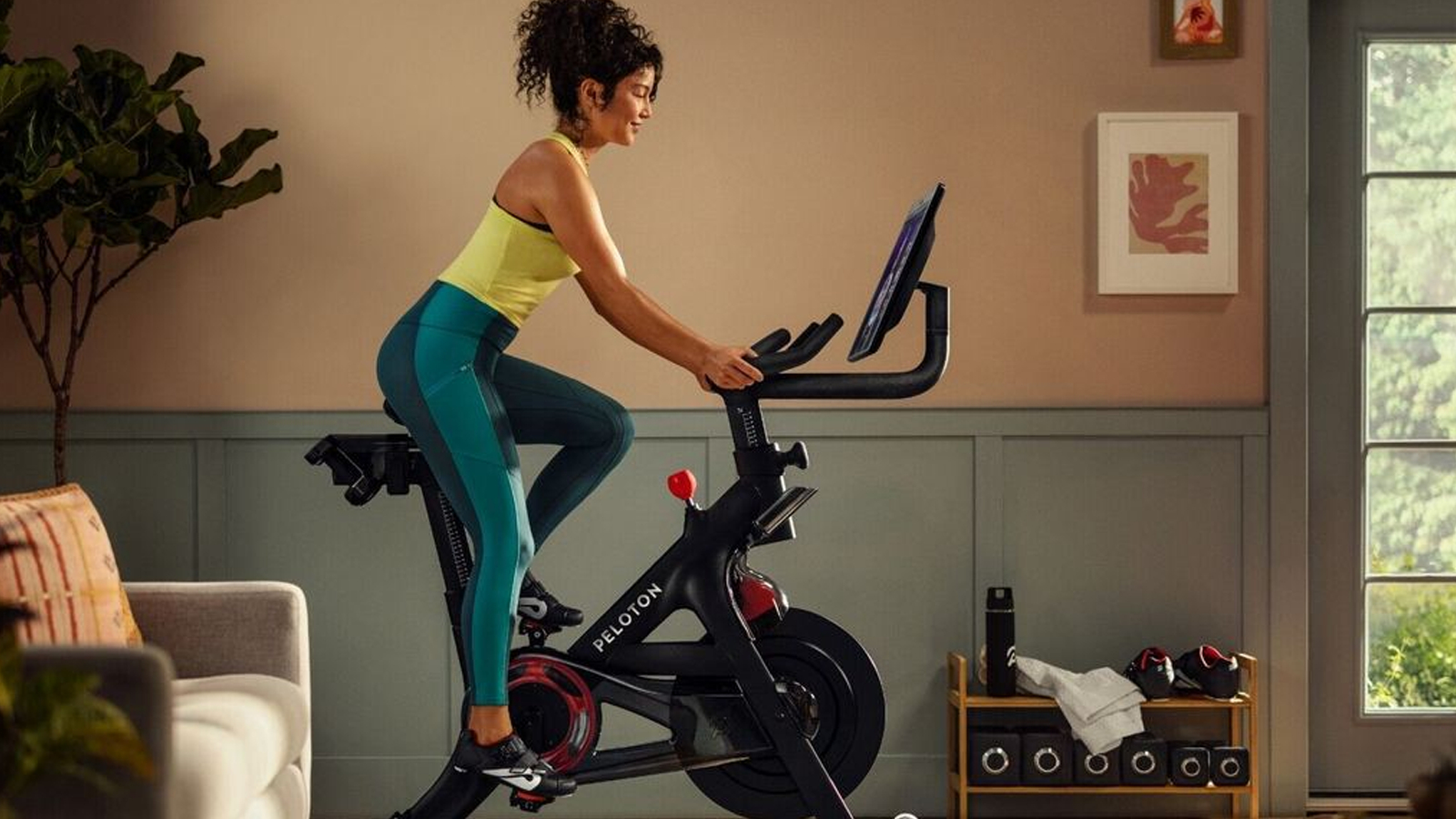
The best exercise bikes come at a range of price points and will do different things depending not just on how much you pay, but the type of exercise bike you buy.
Spin-style exercise bikes such as Peloton and Echelon allow you to join online classes for a workout. They usually work on a subscription basis; you pay for the bike at the start, then a monthly subscription to follow the online routines offered via the large screen that's typically fitted up front.
Our top recommendation is the Echelon Connect Sport, which gives you much the same functionality as the Peloton Bike, but at a more wallet-friendly price.
More basic and cheaper are stand-alone exercise bikes. These just let you sit on and pedal, with a dial to alter the resistance offered. They'll often fold away easily for storage and maybe light enough to carry around the home, but don't give a ride feel that's much like riding a real road bike outdoors.
There is a bit of a difference between indoor cycling vs spinning, but both types are broadly classed as exercise bikes. If you're looking for a bike for indoor cycling, we have a separate guide to the best smart bikes, which work with indoor cycling apps such as Zwift and are a more sophisticated (and expensive) alternative to a turbo trainer.
Choosing the right exercise bike for you can be difficult. Below, you'll find our pick of the best exercise bikes from the basic to the sophisticated. Towards the bottom of the page, there's a buyer's guide to how to choose, with a guide to the key features of an exercise bike.
Quick list: Our top three picks
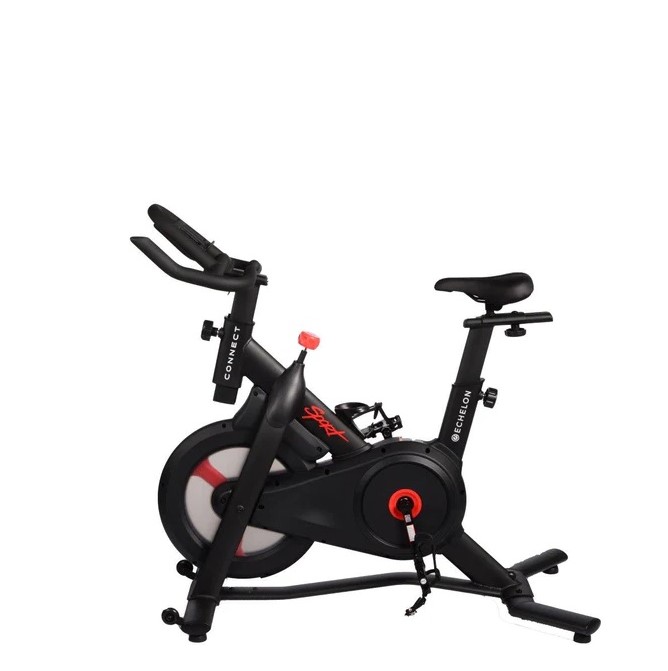
Access to online exercise classes at a lower price
If you are put off by the price of Peloton, the Echelon might be a good alternative, if you have a tablet or screen already.
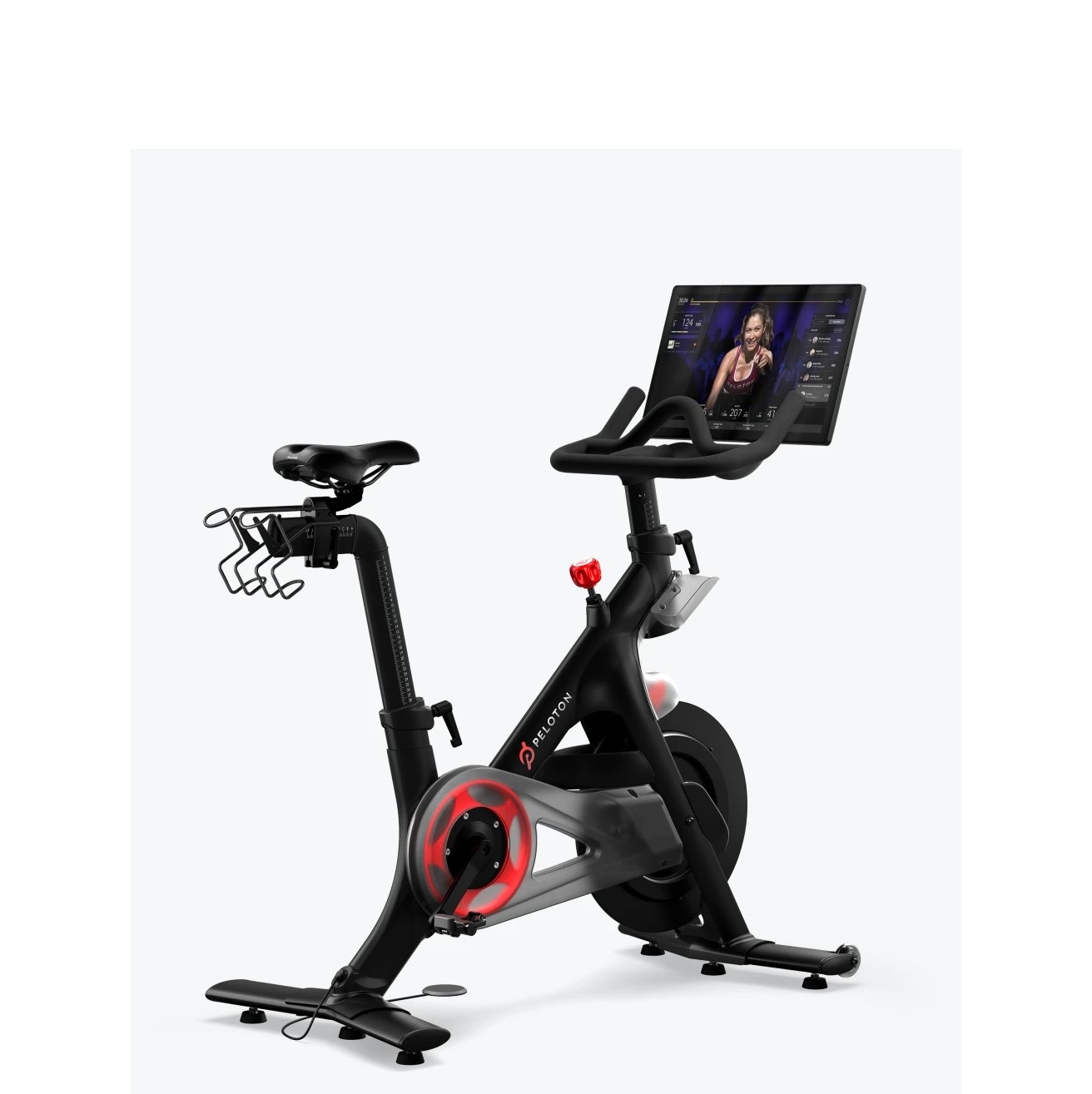
The best way into the Peloton environment
The Peloton Bike + is Peloton's top model, with a 23.8-inch screen and a huge range of workouts available.
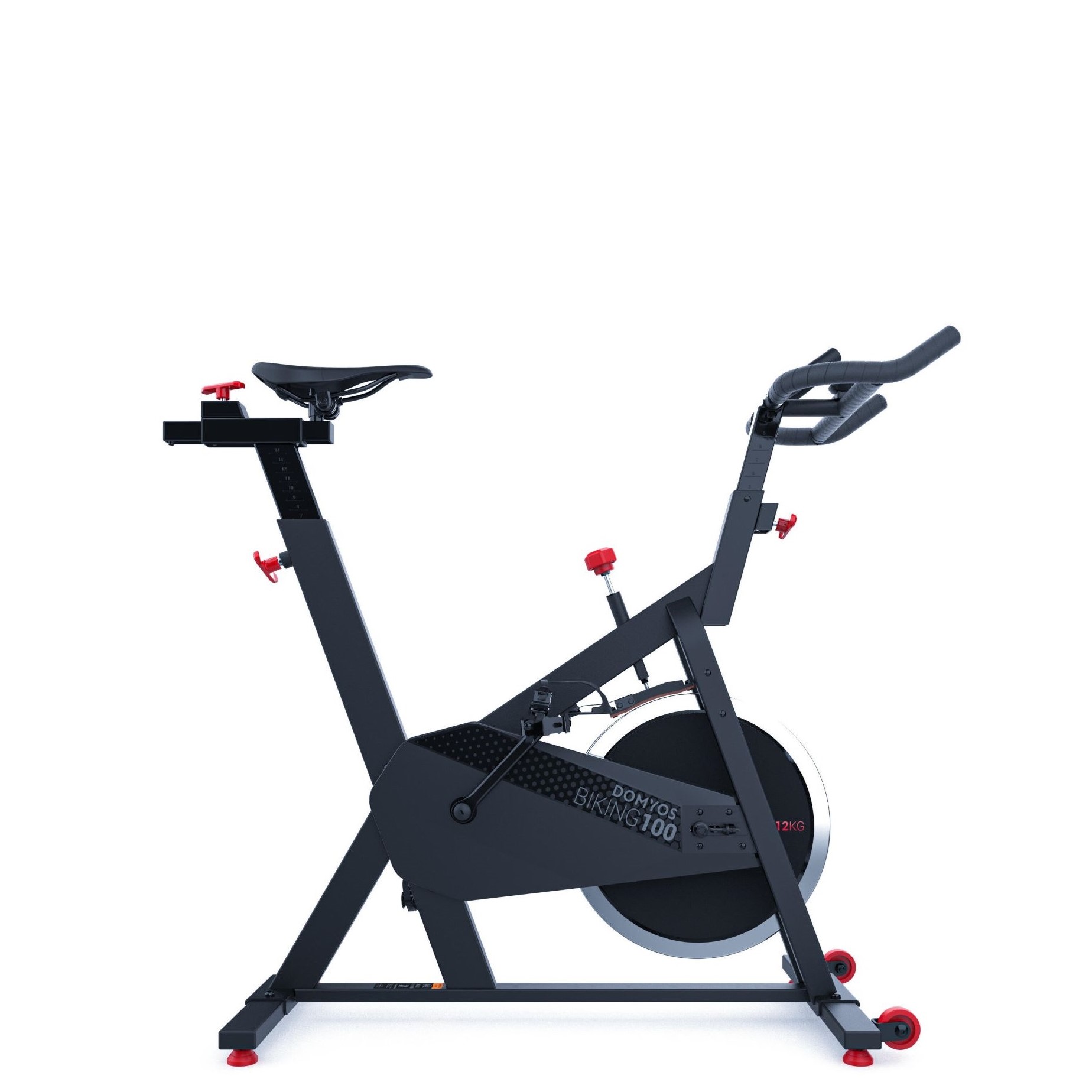
A low-priced option that does the basics well
Decathlon's entry-level exercise bike gives you the stats you need to get exercising, without the frills.
Best exercise bikes
Spin-style exercise bikes
The two big players in the at-home spin bike space are Peloton and Echelon; both are app-based and highly interactive, offering thousands of classes and workouts for you to choose from. Spin bikes will generally prioritise interactivity and community over and above features, and the resistance you pedal against will be either set by an instructor or manually altered by the rider.
Spin bikes normally require the addition of a subscription to continue the usage of the bike, alongside an upfront cost of the bike, so you’ll have to factor in the value of the platform going forward when making a decision about the bike you select.
Best budget Peloton alternative
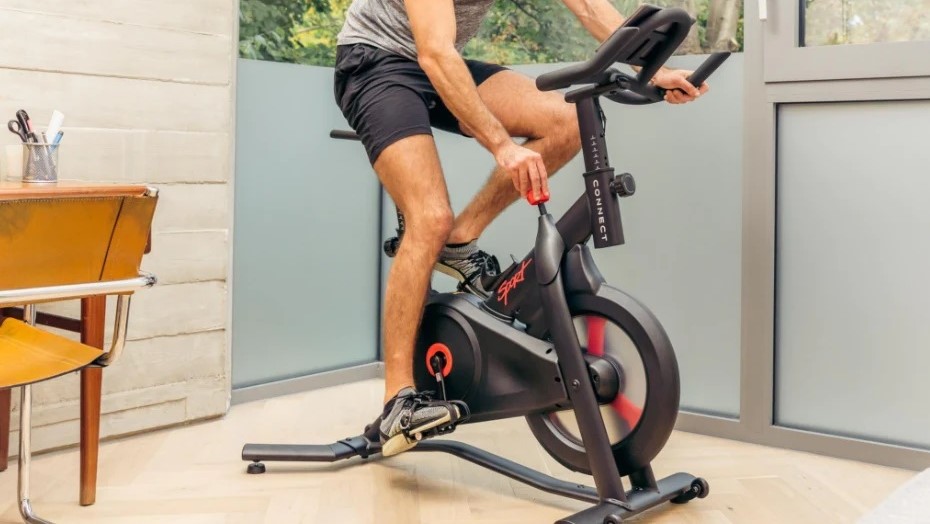
1. Echelon Connect Sport
Specifications
Reasons to buy
Reasons to avoid
✅ You want spin-style workouts but without the Peloton price tag: Not only is Echelon's exercise bike significantly cheaper to buy, but the monthly membership is also more affordable than Peloton.
❌ You don't have a suitable tablet computer at home: To keep costs down the Echelon Connect Sport doesn't have a built-in screen so you will need to have a compatible device to use for your at-home spin sessions.
This budget Echelon exercise bike, the Connect Sport, offers much of the functionality of its higher-priced siblings but saves money by excluding a front-mounted screen. Instead, owners of this exercise bike will need to bring their own screen, which if you already own a smart device such as a tablet (or want the versatility of owning a separate tablet device) won't be an issue at all. Simply load up the Echelon Fit app on your device, connect the bike via Bluetooth, and you'll have access to all the classes you need.
It comes with a 7kg flywheel, which left us wanting more on occasion, although the magnetic resistance did help to prevent the draggy feeling that can plague some of the more budget exercise bikes. A total of 32 resistance levels offers a good spread of difficulty levels, while the 96 x 51cm footprint is stable enough for all but the most rigorous efforts.
Best budget Peloton Bike
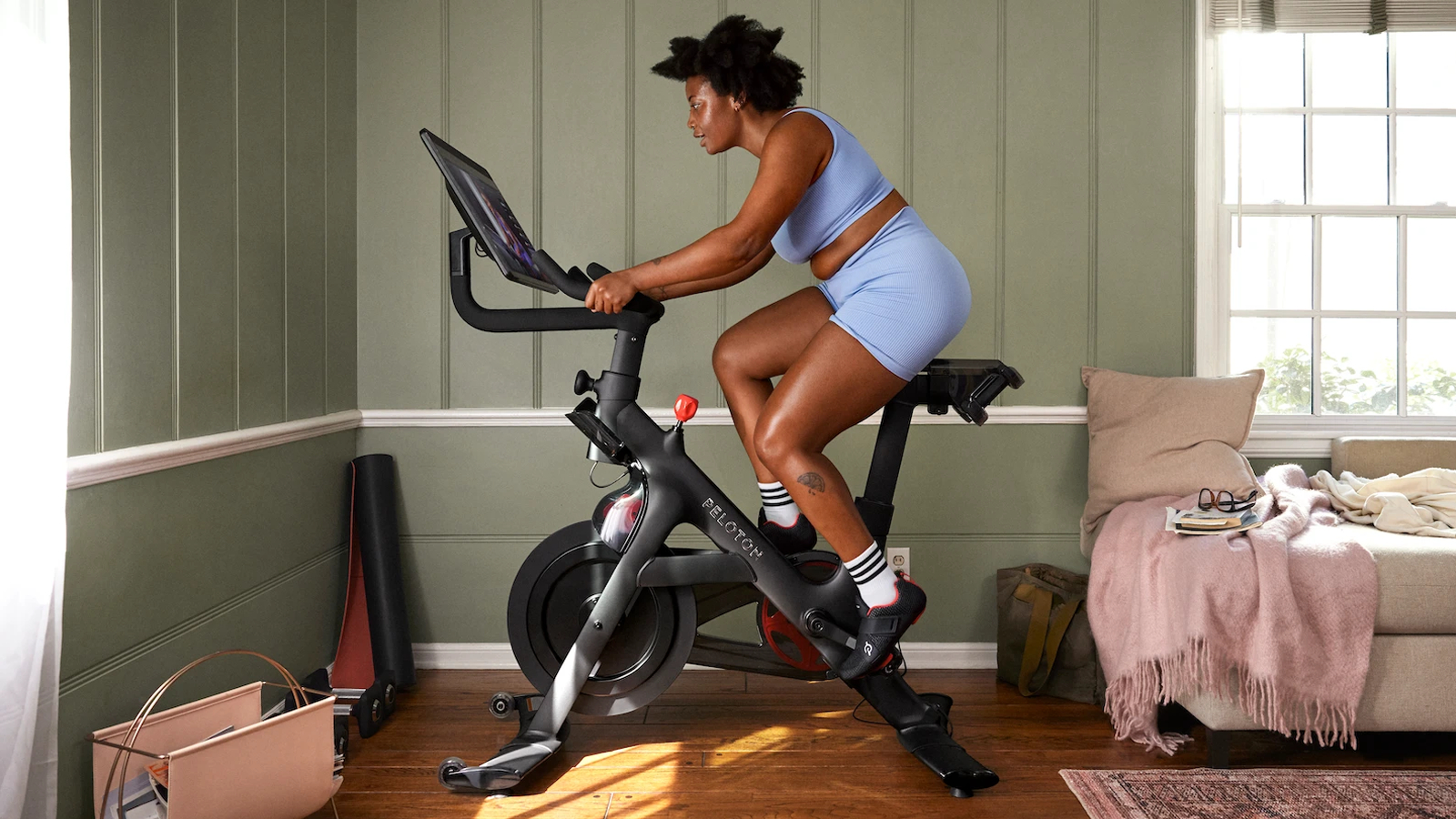
2. Peloton Bike
Specifications
Reasons to buy
Reasons to avoid
✅ You want the cheapest Peloton bike option: The basic Peloton Bike is its most affordable exercise bike.
❌ You want to avoid Peloton's high recurring fee: Don't forget to budget in the monthly membership costs.
❌ You want automatic resistance changes: Automatic resistance change is a feature reserved for the premium Peloton bike, instead you will need to manually control resistance using a knob adjuster.
Exercise bikes have been in gyms for as long as we can remember, but Peloton has changed the game and reinvigorated a segment of indoor training for the masses beyond the Zwifters. In terms of the Peloton Bike itself, it's really not all that revolutionary; a knob near the handlebars adjusts the resistance, a 17kg flywheel maintains inertia, the saddle and bar position are adjustable without tools and there is no freewheel so you can't coast.
But it's not the bike itself that has created the phenomenon, it's the sweatproof 22-inch touch screen at the front. This enormous head unit is WiFi, ANT+ and Bluetooth enabled and runs the Peloton app which features thousands of pre-recorded classes as well as live classes run by professional instructors.
One thing the app doesn’t do is adjust the resistance; you’ll have to do that manually to hit your targets. The higher-priced Bike Plus, seen below, can offer this functionality.
As with any of the other training apps, the sessions range in difficulty from easy spins to disgustingly difficult; there are scenic rides too. Peloton has also added a community aspect to its ecosystem; you can follow and chat with other people who are doing the same class and see live rankings on who is pushing the most watts.
Best premium Peloton alternative
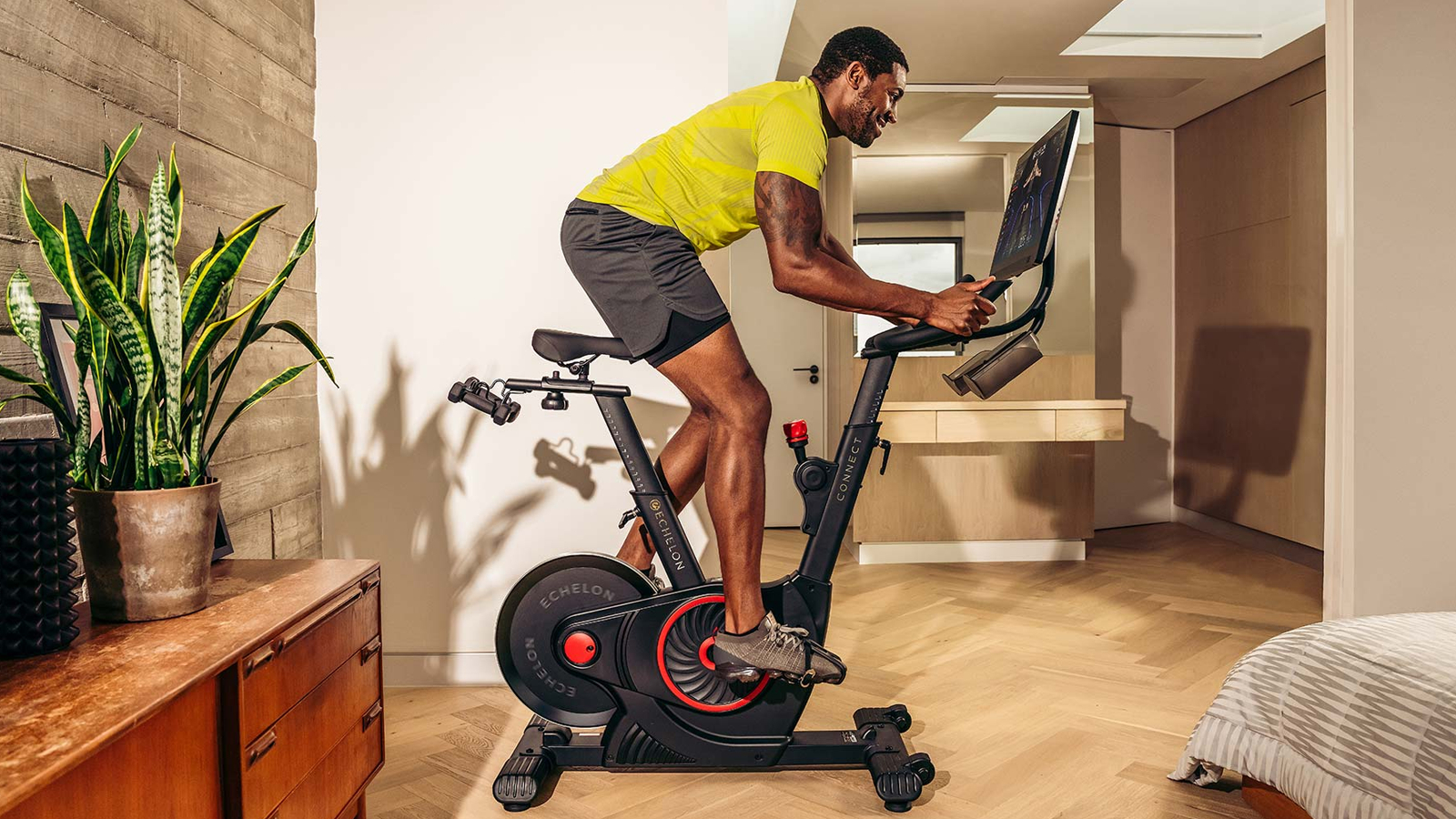
3. Echelon Smart Connect EX-5S
Specifications
Reasons to buy
Reasons to avoid
✅ You want a fully functional Peloton alternative: A large touchscreen makes it easy to follow your workout.
✅ You want deathly silent operation: The magnetic resistance gives a very quiet riding experience so your spin classes shouldn't disturb anyone.
❌ You want automatic resistance changes: The 32 levels of magnetic resistance are controlled using the resistance knob mounted on the central strut.
The EX-5S is a more premium step into Echelon's ecosystem, and in this case, there's no need to bring your own screen, since it comes with a large 22-inch sweatproof HD screen mounted up front. A slightly larger footprint helps to offset the top-heavy weight added by the screen, so I found that it remained stable in all workouts, and it's widely adjustable, so it's fit for most of the family.
The same 32 levels of resistance provide the variable resistance, however, unlike even the budget smart bikes, it still doesn't offer 'ERG' mode, so all resistance changes will need to be done manually, rather than electronically.
Best Peloton exercise bike
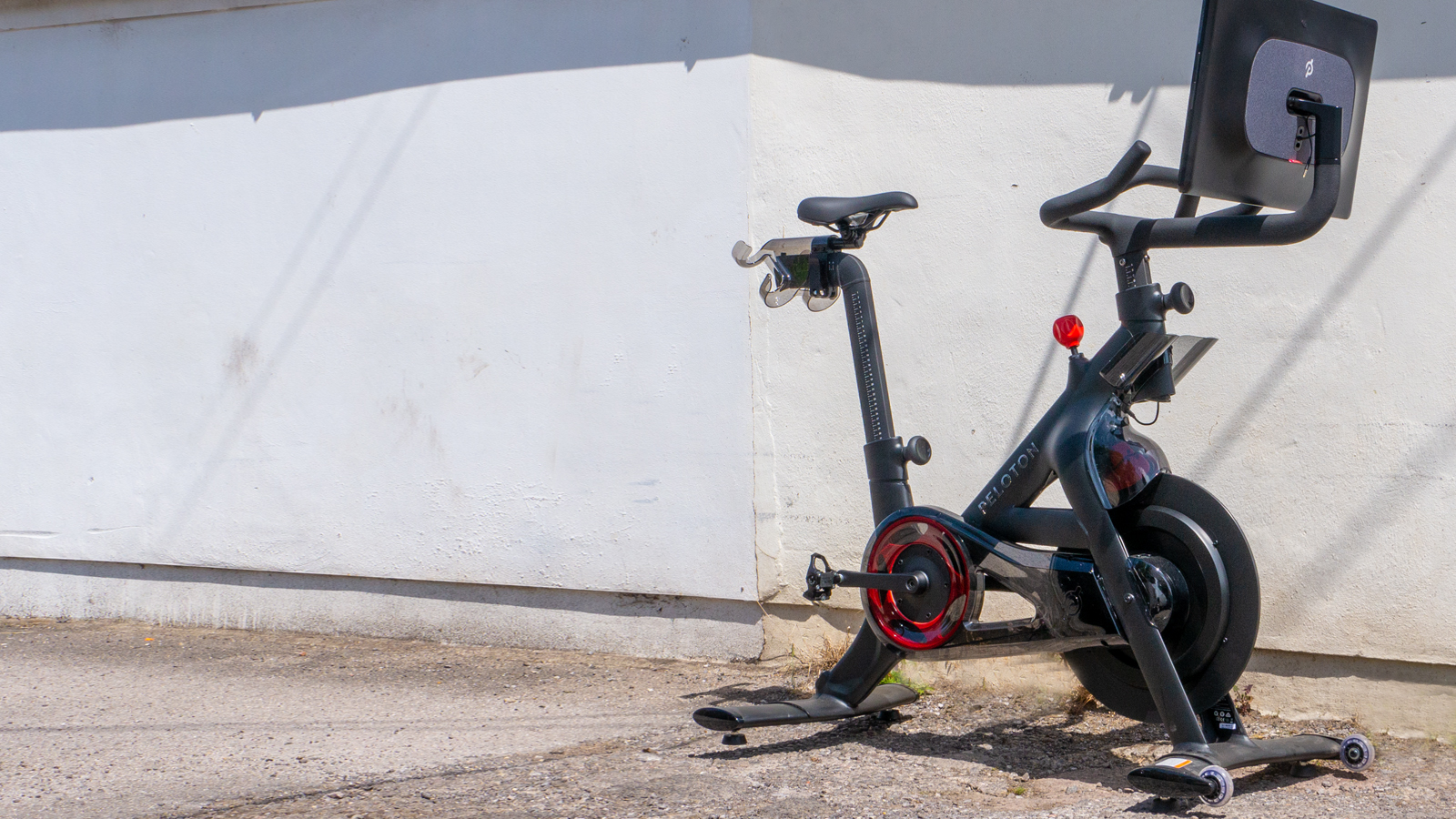
Specifications
Reasons to buy
Reasons to avoid
✅ You want automatic resistance changes in the Peloton ecosystem: With the Bike + the drag can be controlled automatically by your online class instructor so you can concentrate on your effort.
❌ You want to avoid high recurring subscription costs: The Peloton monthly subscription is more expensive than Echelon and significantly more expensive than the likes of dedicated cycling apps like Zwift, TrainerRoad and Wahoo X.
Peloton's most recent response to the rise of the smart bike is the Bike Plus. This takes the original Peloton Bike and adds a slew of updates like a larger screen that is more adjustable, more speakers, a better camera, Apple Watch integration, USB-C charging and more. However, for us, it's the integration of 'auto follow' that sets this Peloton apart from its direct competitors.
Auto-follow - perhaps better known as 'ERG' mode among the smart bike scene - allows the app (in this case, the Peloton app) to control the resistance, rather than relying on the athlete to twist the knob on the top tube (though this does still exist). It also includes a power meter to more accurately measure and report on a rider's output. In use, I found this could be a little delayed at times, but it mostly made life easier, not having to remove your hand from the bars to adjust the resistance.
Among this genre, I see the Peloton Bike Plus as the most complete device currently available, but in my opinion, from both a technological and user interface standpoint, smart bikes still win out due to the addition of gradient replication, power measurement accuracy, and the varying choice afforded by third-party app connectivity.
Read our comprehensive review of the Peloton Bike+ for more.
Budget exercise bikes
The best budget exercise bikes are usually the most straightforward: the ones offering a simple manual resistance and basic trackers to measure your progress against. As with most things budget, you’ll have to consider where you’re comfortable with trade-offs, and what can be compromised to get the right price for your pocket. On budget exercise bikes you’re less likely to get as many features or connectivity as smart or spin bikes, and the pedalling isn’t going to feel quite as true to riding a bike, but you’ll still find models that offer enough to get a good sweat up.
Budget bikes don’t have subscriptions you’ll need to think about and as such, they are more cost-effective in the long run. However, quality and durability should be a big consideration when looking for an exercise bike as it’s always cheaper to keep the bike you have rather than replacing every time a component wears out!
Best for features on a budget
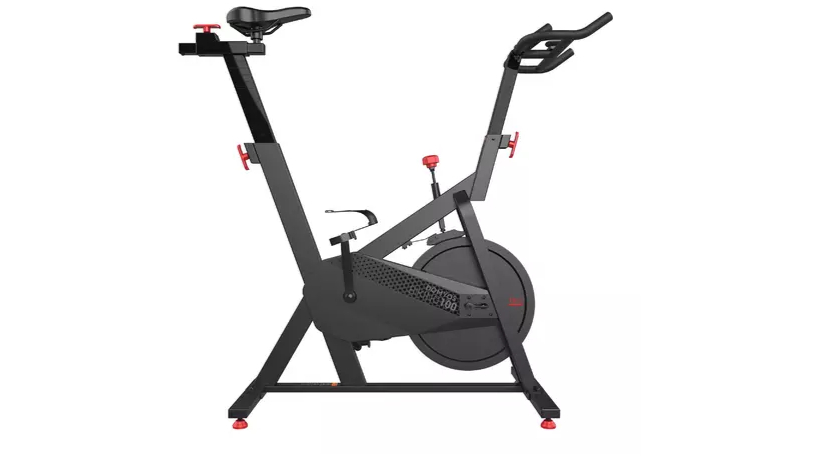
5. Domyos Basic 100
Specifications
Reasons to buy
Reasons to avoid
✅ You want a low-priced design that does the basics well: Basic by name and basic by nature, Domyos' budget option may be no frills but it still performs well.
❌ You want an interactive workout controlled via apps: As the Basic Exercise Bike 100 is a 'dumb' bike it can't connect to any apps or offer any advanced ride metrics.
The 'Basic Exercise Bike 100' from Domyos is a very simple design, but while I found that the overall number of features is low, each one is a welcome inclusion that adds to the experience without unnecessarily adding to the overall cost.
Up front, there is a multi-position handlebar that offers no fewer than 10 different positions. There's a small LCD display at the centre that offers the basic ride metrics like speed and time.
There are a couple of small caveats: at higher resistances, I found the resistance pad can start to heat up and smell due to friction. This isn't detrimental to its performance, but will likely accelerate wear over time. Secondly, the Domyos exercise bike's stability can falter during all-out sprint efforts, as it's not the most planted of things. A small trick here: if your floor is flat enough to do so, remove the adjustable feet and place the bike onto an indoor trainer mat for grip. This lowers your centre of gravity by a couple of inches and helps keep it a little more stable.
Those aside, if you're after a simple exercise bike without the big expense, the Domyos 100 is a good place to look.
Thinking about investing in an exercise bike? You can often save on selected models and accessories by checking our Decathlon coupons before you buy.
Best fold-away exercise bike

6. Pro Fitness FEB2000
Specifications
Reasons to buy
Reasons to avoid
✅ You are short on space: The folding design and 16kg overall weight are suited to those who are tight on space.
❌ You want a realistic ride feel: Riding position, small unstable footprint and the lightweight flywheel limits hard efforts and makes pedalling feel unrealistic.
Not everyone wants or needs a high-tech exercise bike with masses of resistance and oodles of stability. For many people in this world, a simple exercise bike that tracks basic metrics in use, before being compact enough to fold away afterwards is the perfect solution.
Enter the Pro Fitness FEB2000. FEB stands for a folding exercise bike, and this little unit weighs just 16kg, so is easy to carry up the stairs and put away in cupboards when you've finished your workout.
Now, of course, there are some trade-offs: the 3kg flywheel provides about as much inertia as an ant rolling down a hill and is a good few kilos lighter than the Domyos flywheel. I found that this means the pedalling feel is pretty unrealistic, and it's easy to unbalance if you get enthusiastic in your sprinting, but for someone who wants to get the legs moving and elevate the heart rate, this is perfectly up to the task, and the in-built heart rate sensors will help you keep an eye on your progress too.
Best budget spin bike

7. Schwinn IC7
Specifications
Reasons to buy
Reasons to avoid
✅ You want the gym spin bike experience at home without spending big: The stable frame, 18kg flywheel and riding position feel similar to bikes you would find in the gym.
❌ You want a more interactive or real-ride experience: No connectivity means you aren't able to link the IC7 to any automatic or interactive apps or services.
The Schwinn IC7 is a good at-home replica of the 'spin' bikes you'll likely know from the gym. Its fixed freehub and 18kg flywheel take a little bit of extra torque to get going, but the inertia generated helps to prevent that 'pedalling-through-treacle' feeling you can get with cheaper, lighter flywheels.
The IC7 comes with an LCD display that shows your speed, time, distance, RPM, and estimation of calories burned. Its 58cm width and 45kg weight help to make it stable, and while it's certainly possible to unsettle it, I found that doesn't happen during normal use, even when sprinting.
It also comes with dual-sided pedals, which include SPD 'clipless' pedals as well as a toe clip side so you can wear your normal shoes, and this also means it's rideable straight out of the box. Like other simple exercise bikes, you will have to bring your own entertainment, but it comes with a screen holder at the front, as well as a bottle holder for your hydration. And finally, its fit is widely adjustable, so it'll be good for the whole household.
The best exercise bikes compared
| Header Cell - Column 0 | Connectivity | Type | Resistance | Adjustable crank length | Virtual shifting | USB charging port | Flywheel weight |
|---|---|---|---|---|---|---|---|
| Echelon Connect Sport | Bluetooth | Smart spin-style bike | Manual, magnetic | No | No | No | 7kg |
| Peloton Bike | Bluetooth, ANT+, WiFi | Smart spin-style bike | Manual, magnetic | No | No | Yes | 17kg |
| Echelon Smart Connect EX-5S | WiFi | Smart spin-style bike | Manual, magnetic | No | No | Yes | 13kg |
| Peloton Bike + | Bluetooth, ANT+, WiFi | Smart spin-style bike | Manual & electronic, magnetic | No | No | Yes | 17kg |
| Domyos Basic 100 | None | Basic exercise bike (fixed flywheel) | Manual, mechanical | No | No | No | 12kg |
| Pro Fitness FEB2000 | None | Basic exercise bike | Manual, mechanical | No | No | No | 3kg |
| Schwinn IC7 | None | Basic exercise bike (fixed flywheel) | Manual, mechanical | No | No | No | 18kg |
How to choose the best exercise bike for you
With such a wide array of different options competing for the title of best exercise bike, making a decision on which to buy can be daunting. In this section, we'll run you through a few questions to answer and considerations to make, which should steer you in the right direction.
What types of exercise bike exist?
Exercise bikes can be divided into two distinct categories, firstly there are 'Smart spin-style bikes' which are connected versions of the more typical exercise bikes. A prime example is the Peloton Bike Plus. These bikes take the classic spin-class bike with a fixed, heavy flywheel and manually adjustable resistance and then integrate Bluetooth and WiFi to connect your exercise bike to live group classes with real-life instructors and other cyclists from all over the world, all without leaving home.
Secondly, there is the original. These 'Basic exercise bikes' are pretty much exactly the same as the ones you will find in many gyms. These units rarely offer connectivity to third-party apps but will often have a small LCD screen displaying metrics like speed, distance, and time. They also sometimes have an electrical heart rate sensor that you can hold onto. These exercise bikes come in a variety of shapes and sizes from ones that mimic a regular riding position to recumbent-style bikes where you sit behind the pedals.
There are 'Smart bikes', which employ the technology developed for the best smart trainers and integrate into standalone devices. These devices use ANT+, Bluetooth and WiFi technology to connect to your smart device, whether that be a laptop, smartphone or tablet, which you can then use to run indoor cycling apps. These apps have control of the smart bike resistance to provide structured workout sessions which are realistic and engaging. The best smart bikes have a high level of realism with some even tilting back and forth to mimic gradient.
Each of the above styles of exercise bikes has its place and can cater to a variety of riders' needs and requirements.
What do you want from your exercise bike?
Now you know what types exist, you need to consider what you want to get out of it. Do you want to ride in group classes online? Follow a training plan? Ride on Zwift? Race? Just want to ride?
At first thought, you might think there's only one answer to this question, but once you dig into the details of indoor cycling, you'll start to notice there are a lot of ways to answer. If your idea of indoor cycling is of group spin-style classes with an instructor at the helm shouting instructions with loud music in the background, then a smart spin-style bike will replicate that for you at home. These are mostly reliant on a subscription, and the bike itself is commonly locked to a single software platform.
If you don't want the added complexity and cost of connecting to apps or online classes, and you simply want to jump on, stick some music on and ride, then the budget end of the spectrum will have you covered. Basic exercise bikes are just that: basic. They forego connectivity in favour of low cost, and they are therefore often much less expensive than their smart counterparts, and there's no ongoing subscription to factor into the price.
If you wish to replicate the real-world experience as closely as possible, then a smart bike is likely the best choice for you. This will enable you to connect to indoor cycling apps like Zwift, Rouvy, or MyWhoosh, which will put an avatar of you on the screen in front of you. The gradients of the road will then be translated to your pedals, and you can ride with - or against - other avatars being controlled by like-minded cyclists around the world. This opens up group rides, races, and even the eSports World Championships (if you're good enough, of course). In addition, if you wish to follow a training plan or a standalone workout, alternative apps (like TrainerRoad and Wahoo X) will allow you to do this. Most of these exercise bikes come with their own free app, but a subscription to a third-party app will help you make the most of the gamification available.
How much are you willing to pay?
As with most purchases, your budget - or how much you're willing to spend - will dictate your purchase, because smart spin bikes and simple exercise bikes all come with different pricing models.
Smart spin-style bikes have a slightly smaller initial cost than smart bikes. For example, Peloton's Bike is $1,445/£1,345, but you will also need to pay a $44/£39 monthly subscription to the Peloton app if you want to use it. You can technically still use it without that subscription, but it becomes about as feature-rich as the basic exercise bikes below.
Basic exercise bikes start as low as $100/£100 and grow to close to four figures for those with extra features and improved build quality. These have no ongoing cost, but the cheapest versions can be poorly made and finding spares can be tough.
Flywheel weight and bike footprint
A heavier flywheel will give a more realistic ride feel, as the greater inertia will more closely mimic riding outdoors. Around 5kg is a minimum for enough inertia, as anything less will only really allow you to take on the most gentle of spins.
The downside of a heavy flywheel is an exercise bike that's heavy and hard to move around, so if you're going to want to pack your exercise bike away between uses, it's worth looking for a device with a lighter flywheel and lower overall weight, as well as a smaller footprint. Wheels can be a big help too.
A small format has its own disadvantages, as the bike may be less stable if you're going for all-out efforts. Again, it's likely to be fine for a gentle spin though.
Heart rate, cadence or power?
Some of the best exercise bikes measure cadence (the number of crank revolutions per minute), others measure your pulse (heart rate) via electrical sensors on the handlebars, and others again measure power in watts pushed through the pedals.
All of these metrics can be valuable when used correctly, but power is the most useful if measuring your training for improvements over time. If you're considering a device with electrical heart rate sensors, consider the price difference and how it compares to standalone heart rate monitors, which can be bought for around £25/$30 and paired to your phone (and in some cases the exercise bike itself).
Cadence is a useful metric to have access to, but unless gearing and resistance are kept consistent at all times, it's not a great single metric with which to measure your training.

What is a recumbent exercise bike?
Most exercise bikes put you into a standard cycling position, with the saddle broadly above the pedals and the handlebars out in front. A recumbent exercise bike, meanwhile, positions the rider in a more laid-back position, with the seat behind the pedals, not too dissimilar to a driving position.
It can be a good option for those with back issues or limited mobility or balance problems, as it's easier to get onto and stay sat on.
Thinking of buying a smart spin-style exercise bike?
If you want to join online spin-style classes such as those from Peloton, then a smart spin-style bike will provide the best exercise bike for you.
The next big decision to consider is which of the various software programs most interest you. When you buy one of these, you will be tied into a proprietary platform, so make sure you do your research on what each of the platforms offers.
Thinking of buying a basic exercise bike?
If you're looking for a basic exercise bike, the key things to consider are flywheel weight, stability and adjustability. A lightweight flywheel will have less inertia, meaning it will be harder to keep spinning, and can often feel like pedalling through treacle. A heavy flywheel can take a little more effort to get up to speed, but once you're there it provides a more natural ride feel.
Regarding stability, the main issue here is that cheaper exercise bikes are often designed to be compact, and sometimes designed poorly. This can lead to a small footprint and/or a less stable ride, and it can topple over during intense intervals.
On the adjustability front, this might not be an issue if you're of average height, but for anyone who's on the shorter or taller end of the bell curve, you'll need to make sure it can be adjusted to a suitable fit for you.
If multiple users will ride the exercise bike, make sure that the saddle height can be changed quickly. You might also want to adjust bar height and position for multiple users too.
What other features should I look for?
The best exercise bikes will often have a magnetic resistance unit, which allows you to adjust the resistance you're pedalling against, while lower spec units may have a resistance unit which works by friction on the freewheel. This can result in heat build-up with use and fade.
Higher-spec exercise bikes may have the resistance adjusted automatically, while cheaper models usually require you to change resistance manually. Although it's not a term used so much for exercise bikes as for smart bikes and turbo trainers, automatic resistance adjustment may also be called ERG mode.
If you're going to use a tablet or phone to run an exercise routine, look out for a tablet holder, to avoid needing to prop the tablet up on another surface.
Also look out for one or more bottle holders, so you can keep hydrated during a workout.
Is there anything else you should know?
In order to make the most of your newfound indoor cycling hobby, I would recommend buying two accessories.
The first is a pair of Bluetooth-enabled headphones. These will let you connect to your laptop, smartphone or tablet and watch TV, listen to music or simply hear the workout prompts. Wired headphones are workable, but the cable limits how far away from your screen you can be, and might get snagged on the bike in an accident.
The second is a fan. Pedalling without actually moving means there's no airflow across your body to cool you down, and doing so indoors means there's very little airflow at all. The room in which you ride will quickly become hot and humid, and you will sweat profusely. The secret is to maximise movement of air across your skin to evaporate the sweat as it occurs, so while a blast of air direct to the face might feel effective, a more gentle breeze across your entire body will keep you more comfortable and keep your performance up.
How we test the best exercise bikes
When we review an exercise bike, we'll use it over several months to understand how easy it is to live with, what its capabilities and limitations are and everything that makes it one of the best exercise bikes, before we recommend it to readers like you.
If the exercise bike comes with access to classes, we'll follow along, while if it lets you use an indoor app from a different brand, such as Zwift, we'll use that to see how well the two work together.
We'll keep a detailed score sheet for each exercise bike across a number of factors and offer you a balanced appraisal, as documented in more detail in our guide to how we test.
Get The Leadout Newsletter
The latest race content, interviews, features, reviews and expert buying guides, direct to your inbox!

Josh is Associate Editor of Cyclingnews – leading our content on the best bikes, kit and the latest breaking tech stories from the pro peloton. He has been with us since the summer of 2019 and throughout that time he's covered everything from buyer's guides and deals to the latest tech news and reviews.
On the bike, Josh has been riding and racing for over 15 years. He started out racing cross country in his teens back when 26-inch wheels and triple chainsets were still mainstream, but he found favour in road racing in his early 20s, racing at a local and national level for Somerset-based Team Tor 2000. These days he rides indoors for convenience and fitness, and outdoors for fun on road, gravel, 'cross and cross-country bikes, the latter usually with his two dogs in tow.